For those growing up, as I did, in Glasgow in the 1980s and ’90s, the work of Charles Rennie Mackintosh (1868–1928) felt omnipresent, a part of the fabric and texture of the city. The stylised rose motif, like a tray of sweet cakes, the impossibly high-backed chairs, and of course the modern typefaces based on his lettering, full of floating ‘o’s, multiplied bars and decorative marks everywhere. The buildings themselves, of which there weren’t many, seemed almost secondary to the iconography, crowned by James Annan’s photograph of that handsome young man and his bohemian flowing necktie and moustache. But for all the fridge magnets, mugs and tea towels, coffee-table books and advertising, what wasn’t clear to me then was how recently the Mackintosh image had been cultivated as part of the general effort to revive the civic pride of a deindustrialised city. Alongside the ‘Glasgow’s Miles Better’ promotional campaign of 1983, the Garden Festival of 1988 and the European City of Culture in 1990, the city made great show of clutching to its bosom a prodigal son who had left under a cloud and died before he could return. In 2018, the 150th anniversary of the architect and designer is being celebrated in Glasgow with a variety of exhibitions and events, as well as with the restoration of the original Willow Tearooms building on Sauchiehall Street and the recreation of a room from the Ingram Street Tearooms at the new V&A Dundee.
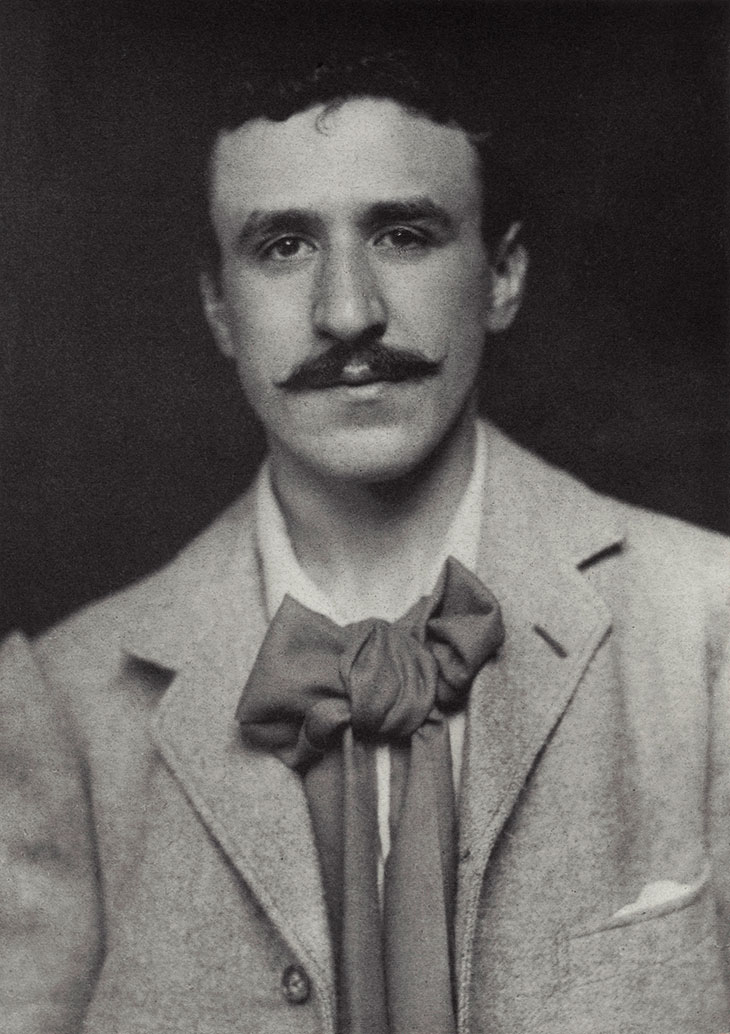
Charles Rennie Mackintosh (1893), James Craig Annan. Courtesy National Portrait Gallery, London
Mackintosh was of comfortable if unpretentious stock (his father worked for the police), and he followed what was then a fairly standard path into the architectural profession, apprenticing first at the firm of John Hutchison, then working as a draughtsman at Honeyman & Keppie from (it is thought) 1889, and taking night classes at the Glasgow School of Art all the while. The local architecture scene of the recent past had been under the influence of the classical revival, of which Glasgow’s Alexander ‘Greek’ Thomson was the most original exponent. An early design by Mackintosh made after winning a travelling scholarship in Thomson’s name is competent work in a conventional Ionic mode.
Glasgow clients were also enthusiastic patrons of the eclectic Beaux-Arts architecture of the late 19th century, especially the free baroque stylings that were applied to the multi-storey office blocks and other commercial types of building springing up at the time, and for which there were no Greek or Roman precedents to be emulated. Honeyman & Keppie were adept at this mode, often using the striking red sandstone that is Glasgow’s most recognisable building material; Mackintosh’s earliest built work, such as his contribution to the Glasgow Herald offices (1894–99) largely exists within this idiom, showing a creative use of ornament that soon put him in the position of leading work on the firm’s competition entries.
The architect’s earliest designs show someone finding their voice within what was already a very innovative and somewhat free environment, confidently composing beyond strict historicism, but Mackintosh is, of course, associated with art nouveau, a term that holds far more radical connotations than, say, its stuffy imperial contemporary, Edwardian baroque. The first signs that Mackintosh was part of this pan-European flowering come in two dimensions, with the graphic work he developed as part of his art school milieu. With his friend Herbert MacNair, he came into contact with the MacDonald sisters, Frances and Margaret, and they eventually married – Herbert and Frances, Charles and Margaret. ‘The Four’, as they were known, produced paintings and graphic designs that also earned them the derogatory nickname of ‘The Spook School’, and there is indeed something very witchy about some of this work, all creeping tendrils and distorted fairy figures, that darkly parallels the commercial work of Alphonse Mucha, and would find a rather creepy echo in the surreal and psychedelic paintings of H.R. Giger over half a century later. The closest parallels to the quartet’s work are the experiments and investigations of Klimt and others in Vienna, although there is little sign of the overwrought sexuality and fin-de-siècle angst that runs through work from the city of Freud and Schoenberg. The Spook School, and the wider milieu of the Glasgow Boys and Glasgow Girls, is less fraught, more compositional, influenced by Celtic themes (although it occasionally tends towards the Wagnerian in treatment, all mystical processions and fetishised medievalism) and complex symbolism, as well as the Japanese designs that were being imported to Glasgow through trade and expositions, in particular the International Exhibition of 1888.
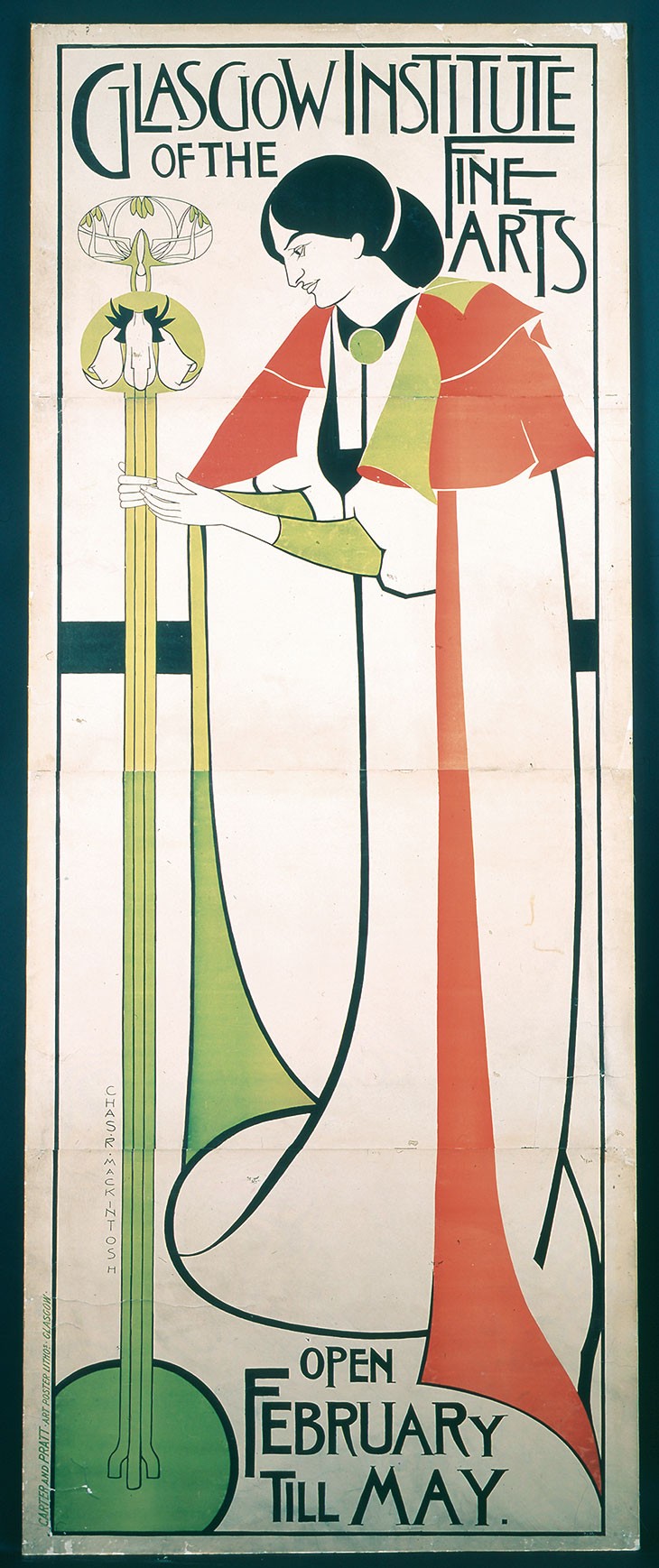
Poster for the Glasgow Institute of the Fine Arts (c. 1894–96), Charles Rennie Mackintosh. Courtesy the Hunterian, University of Glasgow
Back in the offices of Honeyman & Keppie, in 1896, when he was just 28, Mackintosh drew up the competition entry for the new Glasgow School of Art building, a work that has secured his place in the architectural pantheon. The site was a prominent one, set on a very steep slope on Garnethill to the north of the city centre, the brief and budget were stringent, and the architect’s response was primarily pragmatic. The plan was arranged as an ‘E’ shape, with three projecting wings to the south over top-lit basements. The straight northern façade was divided into eight bays, made up of large north-facing studios and an entrance bay, giving an irregular rhythm of eight against five across the central corridor. But from this fairly unremarkable plan, Mackintosh was somehow able to weave together a work of incredible richness and sophistication, partly through composition and decoration, partly through allusion and reference, and partly through groundbreaking spatial imagination. This becomes clear in an examination of the façades, each one of which develops a completely different set of ideas, gradually increasing in complexity.
The short east façade is the most conventional and derivative, and shows the influence of Arts and Crafts architects such as William Lethaby or Charles Voysey. The main south façade, which is least often seen directly, is an essay on the Scottish Baronial, a once-military, then stately style which was of particular scholarly interest to Mackintosh. Fyvie Castle in Aberdeenshire, in particular, is a discernible starting point, but this is not pastiche, and the use of large expanses of roughcast and irregular window patterns creates a striking abstract effect almost akin to Le Corbusier’s post-war works.
The north façade, on the other hand, is the most ostentatiously ‘modern’. An asymmetric set of windows, alcoves, balconies and doorways above a grandly sweeping staircase, rising under an iron arch with lantern, gives entry to the building, a tightly packed composition that is flanked by two rows of vast windows, four sets to one side, three to the other. These, with their gigantic lintels and almost total lack of articulation, giving floods of even northerly light to the painting studios, are the most obvious signs that functionalism, or architecture whose beauty came from unabashed pragmatics, was just around the corner.
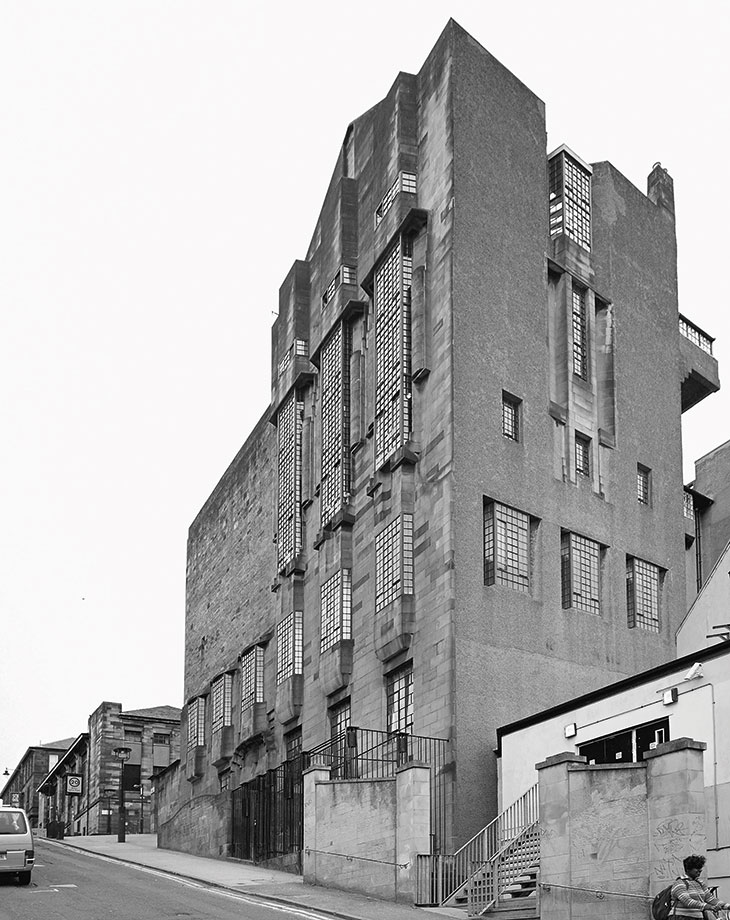
Exterior of the library block of the Glasgow School of Art. completed in 1909 (photo: 2011). Photo: © John Barr/RIBA Collections
But the west façade is where claims of Mackintosh’s genius make most sense. The competition for the building may have been won in 1897, but the need to raise funds meant that the building was constructed in two phases. The earliest designs for the west façade were similar to those for the east, but by the time the second phase began in 1907, Mackintosh had transformed the scheme into something almost completely new. The westerly wing of the south façade presents a roughcast surface that recedes to frame the windows, the returns of which are clear of render; upon turning the corner these appear as projecting elements, an effect of remarkable plasticity. Six oriel bays project from the west façade, three of which carry on vertically to the parapet, with a triple-height glazed oriel window flanked by dummy sculptural recesses.
These windows, reminiscent of but completed before Behrens’ AEG Turbine Factory of 1909 or Gropius’s Fagus Factory of 1913, give light to the library, that virtuosic room that has many times since been interpreted as a fulcrum between classical and modern conceptions of space. This is a double-height room, that receives daylight from two sides, has shelving embedded in the walls, and a gallery on the second level. But this gallery is supported by projecting beams that attach to columns which carry vertically right the way through the space. This partial disengagement, accentuated by plain timber bosses, possesses a dynamism of structural forces poised in equilibrium, contributing to a fluidity of space that is quintessentially modernist. All the timber is darkly stained, the gloom offset by the windows sweeping upwards, with enigmatically abstract decoration applied sparingly but effectively.
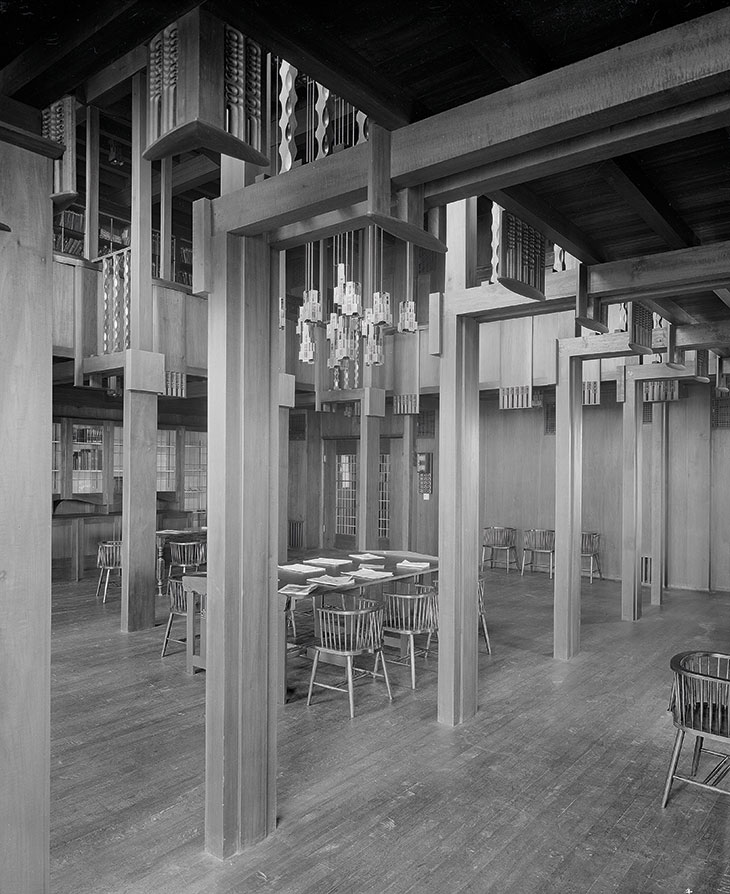
Interior view of the library of Glasgow School of Art, photographed in 1910 by Harry Bedford Lemere. © RCAHMS
There cannot be that many individual buildings that have sustained quite so many PhDs. One could go on and discuss the mock-Japanese decorative ironwork throughout, the mysterious patterns that may symbolically refer to a ‘grove of knowledge’, or the games that Mackintosh plays with light, where the building seems almost upside down, with dark dungeon-like brick vaults at the top and light-filled studios in the basement – but many have done so before. The Art School is, at the end of the day, one of the very best buildings of the early 20th century anywhere in the world, and one which, until the disastrous degree-show fire in 2014, was still hard at work and filled with art students, although in recent years the incessant guided tours have made it feel a little like a living museum.
The entire Art School job took 12 years to complete, and Mackintosh would never build anything of comparable scale again. Other projects include the Scotland Street School (1903–06), which has almost completely glazed cylindrical stair towers, or the Willow Tearooms, which extended the language of the Art School library in a more luxurious yet geometrically harder direction. The tearooms were furnished with the infamous high-back chairs – visually elegant with their accentuated verticals, yet hardly something you’d look to settle into after work.
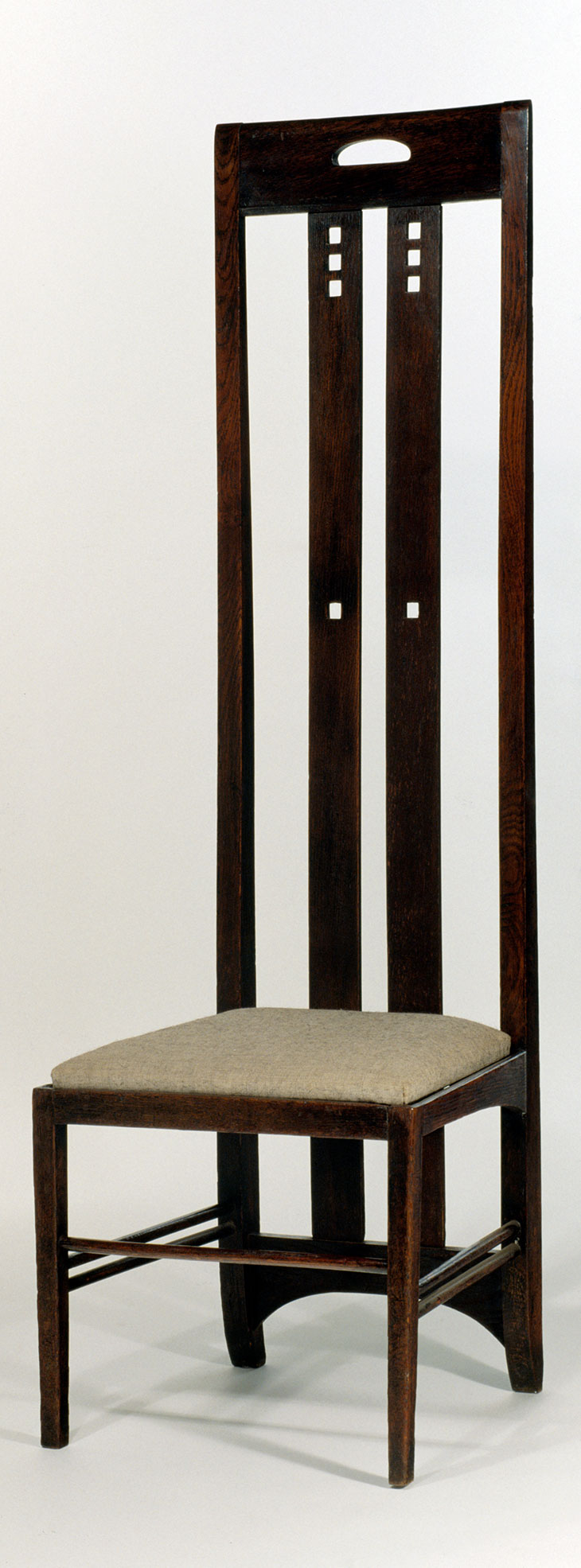
High-backed chair designed for use in the Ingram Street Tearooms (c. 1900–1901), Charles Rennie Mackintosh. © CSG CIC Glasgow Museums
This stiff delicacy is also found in Mackintosh’s domestic projects such as Windyhill and the Hill House, or his and Margaret’s house on Hillhead Street, now recreated as part of the Hunterian. In these projects, Arts and Crafts touches such as nooks and niches designed for very specific moments of domestic life are combined with an innovative control of natural light, and the highly specific decorative schemes that at times, in the case of the Mackintosh’s own living room, have a calming, almost otherworldly austerity, while at others, such as at 78 Derngate in Northampton, are almost migraine-inducing in their Op-art busyness.
In 1901 Mackintosh had been made a partner at what was by then Honeyman, Keppie and Mackintosh, but work was getting harder in general. He was not clubbable in the way that his partners were, and failed to bring work in off the golf course. His early success in competitions wasn’t much repeated, despite whisky-fuelled all-nighters in the office, and it seems he could be the quintessentially difficult architect – making constant alterations, going behind the client’s back and so on. Furthermore, the influence of new American architecture was blocking any chance of winning work with more avant-garde designs; art nouveau was seen as passé, and the Beaux-Arts style was on top again. In 1913 Mackintosh left the partnership, left Glasgow and headed south. He attempted to pick up some work in London, and some Chelsea studios he designed in the years after the First World War are tantalisingly unbuilt.
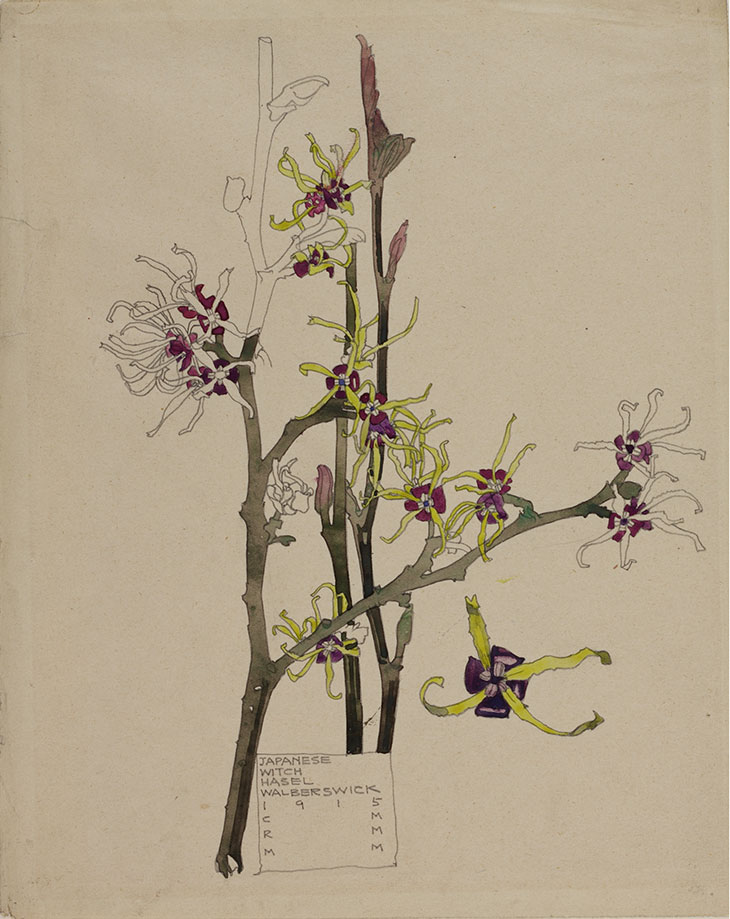
Japanese Witch-Hazel (1915), Charles Rennie Mackintosh. Courtesy The Hunterian, University of Glasgow
A further move in 1923 took the Mackintoshes to France, where Charles primarily produced watercolours. And while turning to painting was a form of retreat, his pre-war botanical drawings are particularly exquisite, with a pencil line as effervescent and vital as Egon Schiele’s hand. The landscapes are also accomplished, but less energetic, losing slightly the head-shaking loveliness of his travel sketches. But by the late 1920s his health was breaking down, and he returned to the UK to succumb to tongue and throat cancer at the age of 60.
At the time of his death in 1928, Mackintosh was not considered particularly significant; and his British reputation – as an architect who was fêted abroad – continued for at least a decade. He was highly regarded in Vienna, and had been exhibited at the 1900 Secession and elsewhere across Europe, but work so idiosyncratic was unlikely to be imitated. It was Nikolaus Pevsner who cemented the ‘correct’ line on Mackintosh, writing in Pioneers of the Modern Movement (1936) that Mackintosh was ‘one of the most imaginative and brilliant of all young European architects’, adding that he was ‘the real forerunner of Le Corbusier’. This interpretation has stuck and since then Mackintosh has generally been seen as a firmly forward-looking 20th century architect.
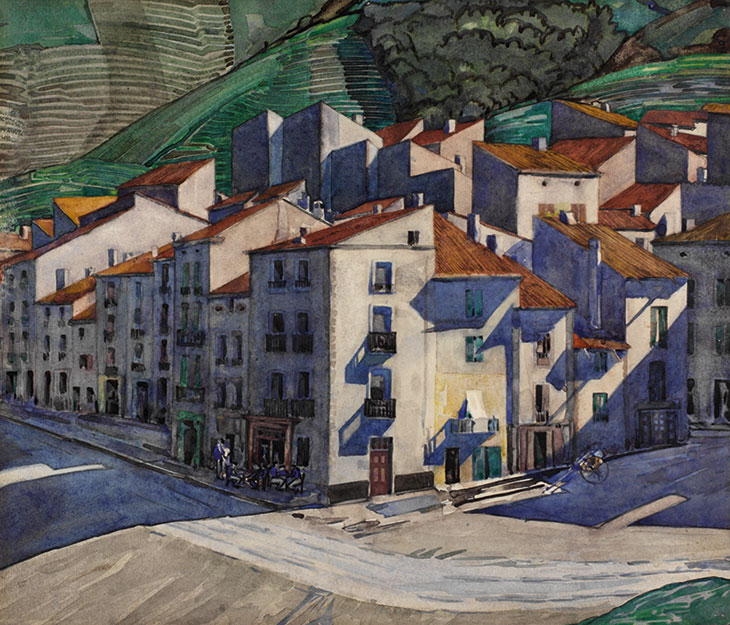
A Southern Town (1923–27), Charles Rennie Mackintosh. Courtesy the Hunterian, Glasgow
But his direct influence isn’t easy to trace. It’s certainly true that leading Scottish modernists such as Isi Metzstein and Andy MacMillan of Gillespie, Kidd & Coia, who for many years ran the Mackintosh School of Architecture (which finds itself housed in a mediocre concrete submarine directly across the road from its namesake building), were experts in Mackintosh’s work (as are the younger duo of Benson & Forsyth), but their hardcore modernism tends to take very technical devices from Mackintosh, such as contrasting spatial sequences of dark into light, which are not obvious when executed in a different idiom.
More recently, after a fire ripped through the west wing of the Art School in 2014, Gavin Stamp made a strong case against seeing Mackintosh as a forerunner of modernism, noting attempts to downplay his collaboration with Margaret (by those who sought to purge the work of what they regarded as its fey, decorative tendencies), and concurring with the view of Mackintosh as ‘the last and one of the greatest of the Victorians’. In the notes for a lecture he delivered in 1902, Mackintosh himself wrote (under the heading ‘unuttered utterances’), ‘Let us look upon the result of the world’s artistic achievements as the beginning of the morning of our lives – not the grave of our aspirations, the death knell of our ambitions.’ There is truth in both interpretations.
Restoration of the Art School building continues, and the – in my opinion – sensible course of action has been taken to rebuild the library without pretending it is not new construction. At the time there was much debate about what should be done, with many suggesting that a competition be held for a new design. The implication seemed to be that a 28-year-old genius might be found. But modern construction is completely different – more complex and more difficult – and it takes longer to mature as an architect. Creativity such as Mackintosh’s still exists, but it could only find its brief moment of expression in a booming environment trying to come to terms with the onrushing industrial world.
‘Charles Rennie Mackintosh: Making the Glasgow Style’ is at Kelvingrove Art Gallery and Museum until 14 August; ‘Mackintosh at the Willow’ opens on 7 June.
From the May 2018 issue of Apollo. Preview and subscribe here.
Unlimited access from just $16 every 3 months
Subscribe to get unlimited and exclusive access to the top art stories, interviews and exhibition reviews.

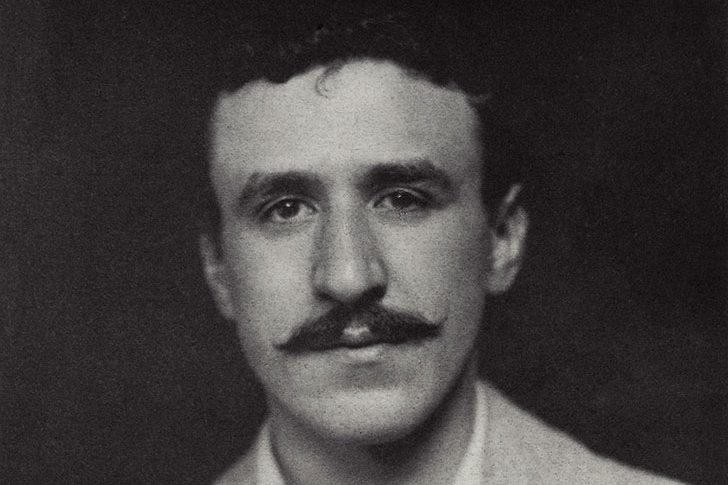
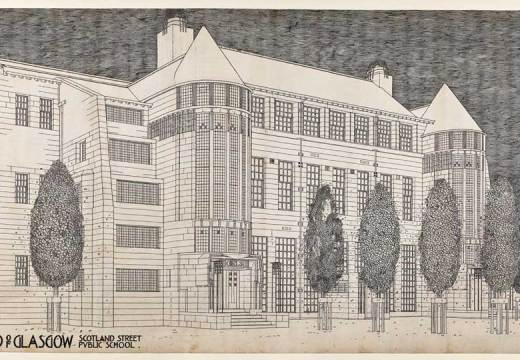
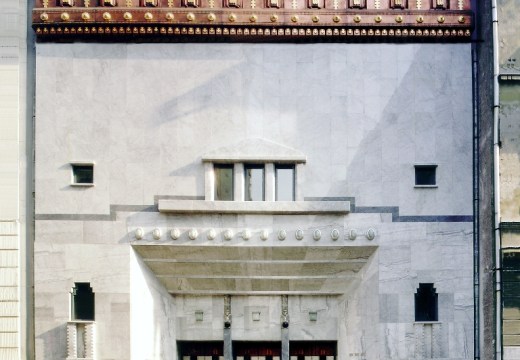
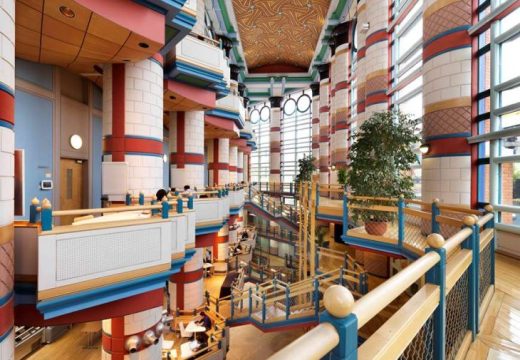









![Masterpiece [Re]discovery 2022. Photo: Ben Fisher Photography, courtesy of Masterpiece London](http://www.apollo-magazine.com/wp-content/uploads/2022/07/MPL2022_4263.jpg)
It’s time for the government of London to return to its rightful home